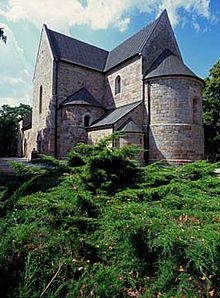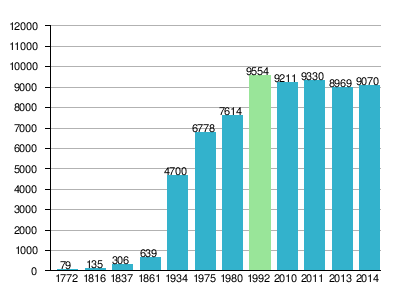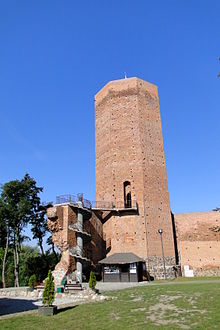Kruszwica
| Kruszwica | ||
|---|---|---|

|
|
|
| Basic data | ||
| State : | Poland | |
| Voivodeship : | Kuyavian Pomeranian | |
| Powiat : | Inowrocławski | |
| Gmina : | Kruszwica | |
| Area : | 6.64 km² | |
| Geographic location : | 52 ° 40 ′ N , 18 ° 20 ′ E | |
| Residents : | 8995 (December 31, 2016) | |
| Postal code : | 88-150 | |
| Telephone code : | (+48) 52 | |
| Economy and Transport | ||
| Street : | Włocławek - Gniezno | |
| Next international airport : | Poznań-Ławica | |
Kruszwica ( German Kruschwitz , older also Kruswick ) is a town in the powiat Inowrocławski of the Kuyavian-Pomeranian Voivodeship , Poland . It is historically significant and the seat of the town-and-country municipality of the same name with around 19,600 inhabitants.
Geographical location
Kruszwica is 14 kilometers southeast of the city of Inowrocław ( German Hohensalza ) in the Pojezierze Gnieźnieńskie ( German Gnesener Seenplatte ) at the northern end of the large Jezioro Gopło ( German Goplosee ) through which the network flows , namely at the point where the network leaves the lake and continues towards Bydgoszcz ( German Bromberg ) in the north. The Montwy River rises about two kilometers from the city. The city, surrounded by forest areas, is a popular tourist destination.
history




The oldest traces of settlement date from the Neolithic Age (3,900 - 1,800 BC). On 500 BC A castle on Ostrów Rzępowski (currently Półwysep Rzępowski) is dated. The settlement was favored by the particularly fertile soils, the natural resources and the geographical location. The development of the city was also favored by its location on the Amber Road and the route from Greater Poland to the Kievan Rus .
In the 8th and 9th centuries Kruszwica was the capital of the ancestral state of the Goplanen. At the end of the 9th century it was incorporated into the state of the Polans, whose main castle was in Gniezno .
The later legend of Popiel and the Mice , which was first written down by the chronicler Gallus Anonymus in 1115/1116, is linked to these events . The legend that was handed down early and is very popular in Poland tells that Popiel II, the Duke of Poland, fled with his wife to the mouse tower of castrum Crusuicz on Lake Goplo after an insidious murder around 840 and was eaten there by the mice. Thereafter, Piast came to rule over Poland as the successor to Popiel. According to the Chronicle of Wielkopolska from the 13th century, the wagon maker Piast was the father of Siemowit and Siemowit was the father of Lestek , whose son in turn was Siemomysł , the father of Mieszkos I - the first historical ruler of Poland.
Probably the most important castle of the Goplanen was a strongly defended settlement about 20 km south of Kruszwica. It was incorporated into the Polanen tribe along with the Goplanen tribe . Therefore, during the 10th and 11th centuries, an important settlement center with a castle on the peninsula, where the Polish princes and kings resided, was built in Kruszwica. The Kruszwica Castle was considerably expanded. The place should also have been an important market, because important trade routes crossed here, leading from the Oder to Lithuania and Ruthenia and from Kalisch to Danzig . Kruszwica was also an important handicraft center. Evaporated salt was extracted from the brines there. The name of the city is also traced back to the Polish word kruszwy (blocks of salt).
The development of Kruszwica was badly shaken in 1096 when the town-like settlement gave refuge to his rebellious son Zbigniew during the reign of Senior Duke Władysław I. Herman , whereupon the Senior Duke finally had it burned down. In the 12th and 13th centuries, however, it rose again and now had more residents than before. The name Cruciuis is found in 1133 and Crusvicia in 1193. In 1149, a meeting with Margrave Albrecht the Bear , Otto I (Bavaria) and other princes took place here. In 1157, Emperor Barbarossa led a German army into this area and as far as Kruschwitz, where the Duke of Poland showed him a certificate of submission.
From the end of the 12th century, Kruszwica Castle was the seat of the Kruszwica castellan . A little later he built the monastery of St. Peter and Paul and the castle church of St. Wita in Kruszwica . In the 12th century there were also other church buildings. a. the St. Godehard Hospital in Hildesheim . During this time Kruszwica should also bishopric of the diocese Włocławek have been. Under Bolesław III. Schiefmund and Bolesław IV experienced a further boom in Kruszwica.
In June 1230 Konrad von Masowien left the neighboring Kulmerland to the Teutonic Order in the Treaty of Kruschwitz as a fief or donation and left him with all claims to the Prussian land adjoining it to the north .
In 1268 Duke Siemomysław von Kujawien gave the castle to Duke Bolesław VI. the pious one . He had the castle burned down again in 1271, fearing that the Pomeranians might establish themselves here. In 1332 the castle was conquered by the Teutonic Order and occupied for five years.
From 1350 to 1355, King Kazimir the Great built the great castle (with a "mouse tower") as the seat of the castellan and starosts. Around the middle of the 13th century, a toll was levied on the Kruschwitz Bridge. After Kasimir's death, the castle belonged to the Pomeranian Prince Casimir IV of Pomerania-Stolp from 1370 to 1377 ; when he died of a wound on January 2, 1377, the castle fell back to the Polish crown. In 1383 the Mazovian palatine Abraham Szocha took the place; Kruschwitz then probably passed into his fiefdom. In 1422 Kruszwica received city rights from King Władysław II Jagiełło .
The Swedish raids in the Second Northern War between 1655 and 1657, experienced by the citizens as the “ Swedish Flood ”, plunged Kruszwica into ruin. The great castle was completely burned down along with the city.
Since August 5, 1772, as a result of the partitions of Poland , Kruszwica belonged to the Kingdom of Prussia and was called Kruschwitz in German . Up to this point in time there was a castle starost in the castle. Around 1783 there were only eleven houses left in the once important city, in which 74 people lived.
A renewed rise did not begin until the end of the 19th century, when a sugar factory (1880), a railway line (1889) and a number of smaller businesses were built here. During this time, Kruszwica also helped build the Bydgoszcz Canal , which increased shipping traffic on the network . Until 1919 Kruschwitz belonged to the district of Strelno in the administrative district of Bromberg in the province of Posen of the German Empire . After the First World War , the region with the city had to be ceded to the Second Polish Republic due to the provisions of the Versailles Treaty in 1920 .
During the years 1920 to 1939 Kruszwica invested heavily in the food and agricultural industries. In 1939 the region was occupied by the German Wehrmacht and, contrary to international law, incorporated into the German Reich. The city belonged to the Reichsgau Wartheland until 1945 . Towards the end of the Second World War , the region was occupied by the Red Army in the spring of 1945 . Unless they had fled before the end of the war, the German residents were subsequently expelled by the local Polish administrative authorities .
In the years 1952 to 1956 the most important industrial company was established, the Kujawskie Zakłady Przemysłu Tłuszczowego, one of the largest margarine factories in Poland.
In June 1960 the nationwide celebrations for the 1,000th anniversary of the founding of the first Polish state took place in Kruszwica. An administrative reform then incorporated Kruszwica into the Bydgoszcz Voivodeship . It has been part of the Kuyavian-Pomeranian Voivodeship since 1999 .
local community
The town itself and 30 villages with school administration offices belong to the town-and-country municipality (gmina miejsko-wiejska) Kruszwica.
Culture and sights
- City center on the western bank of Jezioro Gopło. The development of the market and the neighboring streets dates from the 19th and 20th centuries
- Kruszwica Mouse Tower , a remnant of the large castle that was destroyed by the Swedes. King Kazimierz Wielki had it built here together with the mouse tower as the seat of the castellan and starost of Kruszwica in the middle of the 15th century. From the mouse tower you have a wonderful view of the city and the Gopło. A permanent exhibition in the mouse tower shows the history of Kruszwica
- The Romanesque collegiate basilica of St. Peter and Paul from the years 1120 to 1140. The three-aisled church is built from granite and sandstone blocks. It is said to be "a witness of nine centuries". The church is one of the oldest in Poland, possibly the oldest. Restored in the middle of the 19th and 20th centuries.
- Catholic Church of St. Teresa of Ávila on Kruszwicaer Markt from 1922
- 19th century sugar factory building
- Traces of early settlement at the southern end of the Rzępowski peninsula
- Nadgoplański Park Tysiąclecia (1882.65 ha nature reserve)
Economy and Infrastructure
Population numbers
- 1772: 79
- 1783: 74 Poles
- 1816: 135
- 1843: 386
- 1861: 639
- 1885: 1.606
- 2014: 9,070

In 1772 Kruszwica was the smallest town in the Kingdom of Prussia with 79 inhabitants .
Transport links
Rail transport
The following railway lines run through the town of Kruszwica or its neighboring towns:
- PKP railway line 231 Inowrocław Rąbinek– Mogilno , no more passenger traffic
- PKP railway line 131 Chorzów Batory - Tczew , only long-distance traffic without stopping in the municipality
Road traffic
The following federal highways run through the town of Kruszwica:
- Droga krajowa nr 62 Strzelno - Siemiatycze
- Droga wojewódzka nr 412 Kruszwica – Tupadły
Air traffic
The Poznań-Ławica International Airport is from the nearest airport from Kruszwica.
Personalities
- Ewa Lewańska , painter
- Stanisław Makowski , captain in the British Army and soldier in the French resistance movement
- Jan Kasprowicz (1860–1926), Polish writer, poet, literary translator and university lecturer
- Stanisław Przybyszewski (1868–1927), Polish writer who wrote in German at the beginning of his career
- Zbigniew Przybyszewski , commander, heroic defender of the Polish Hela peninsula
- Janusz Drzewucki , Polish poet, literary critic, journalist, editor
- Juliusz Trzciński , Polish politician, Minister in the "First Council of Wincenty Witos"
Others
Kruszwica appears as a setting for important Polish literary works:
- Juliusz Słowacki : Balladyna, Lilla Weneda, Król Duch
- Józef Ignacy Kraszewski : Stara Baśń
- Ignacy Krasicki : Myszeida
- Jan Kasprowicz : Sonety znad Gopła
- Władisław Bodnicki: Syn Popiela
- Stanisław Helsztyński: Zmierzch Popielitów
- Julian Ursyn Niemcewicz : Śpiewy historyczne
- Wincenty Pol : Gopło
- Czesław Miłosz : Król Popiel
- Janusz Drzewucki : the poems Ulica Kolegiacka w Kruszwicy; Powrót do Kruszwicy; Kruszwica, lipiec, pełnia życia; Widok z Mysiej Wieży
literature
- Heinrich Wuttke : City book of the country Posen. Codex diplomaticus: General history of the cities in the region of Poznan. Historical news from 149 individual cities . Leipzig 1864, pp. 348-350.
- Johann Friedrich Goldbeck : Complete topography of the Kingdom of Prussia. Second part, which contains the topography of West Prussia . Kantersche Hofdruckerei, Marienwerder 1789, p. 92, no. 2.).
- Gotthold Rhode , History of Poland , 3rd edition Darmstadt 1980, ISBN 3-534-00763-8
Web links
- Official website of the city of Kruszwica
- Kruszwica in the Geographical Lexicon of the Kingdom of Poland , Volume IV (Kęs - Kutno) from 1883
- Kruszwica on regionwielkopolska.pl
Individual evidence
- ↑ http://rcin.org.pl/dlibra/doccontent?id=12216
- ↑ a b c d e f g h i Heinrich Wuttke : City book of the country of Posen. Codex diplomaticus: General history of the cities in the region of Poznan. Historical news from 149 individual cities . Leipzig 1864, pp. 348-350.
- ↑ After Jan Długosz under Mieszko I in Kruszwica a diocese for Kujawia was created, but it was soon dissolved again. Unfortunately, the dissolution of the diocese is nowhere documented. In contrast, the establishment of the diocese in Włocławek by Bolesław III is documented in 1123 . Crooked mouth . Therefore, some historians consider Długosz's statement to be doubtful.
- ^ King Władysław II Jagiełło granted Magdeburg city rights on June 8, 1422
- ^ A b Johann Friedrich Goldbeck: Complete topography of the Kingdom of Prussia. Second part, which contains the topography of West Prussia . Kantersche Hofdruckerei, Marienwerder 1789, p. 92, no. 2.).
- ^ Michael Rademacher: German administrative history from the unification of the empire in 1871 to the reunification in 1990. pos_strelno.html. (Online material for the dissertation, Osnabrück 2006).









